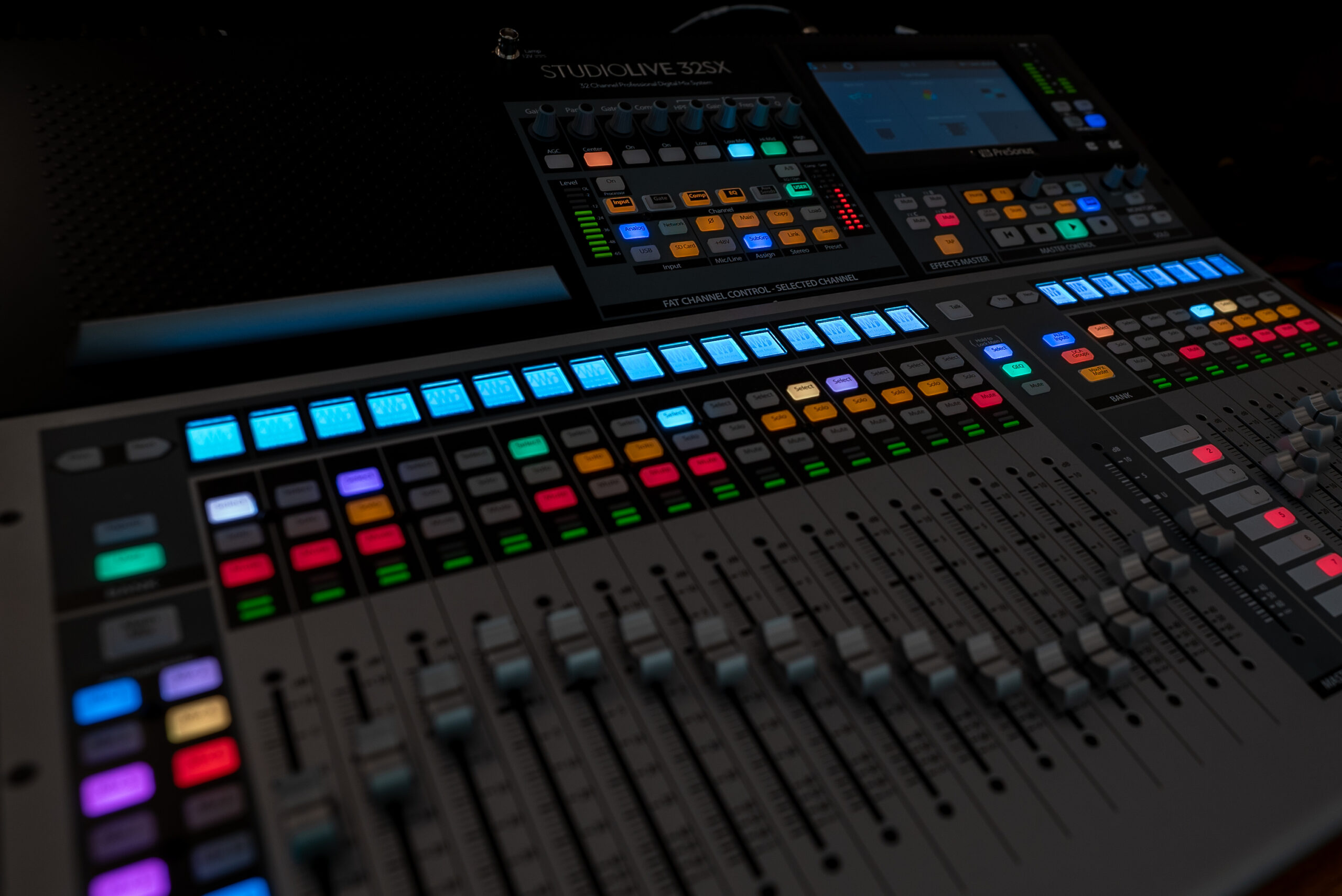
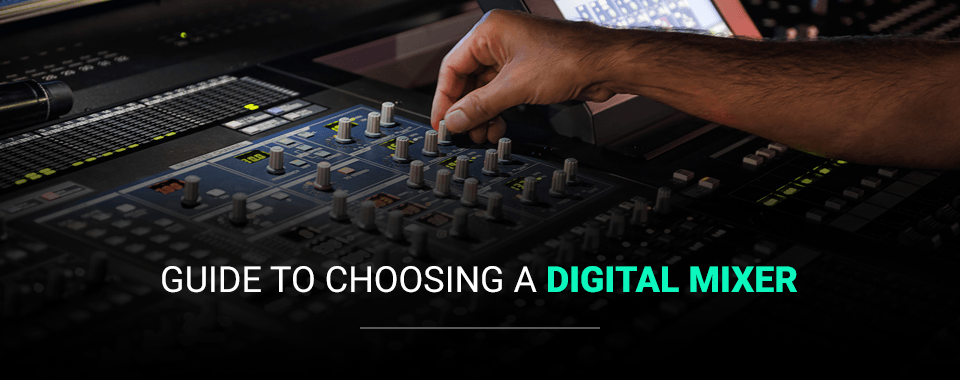
Do you hear that smooth, crisp sound flowing out of your speaker system? Whether you’re jamming to your favorite band or watching an action-packed film, the serene sound waves hitting your ears sound fantastic because of digital encoding. Digital audio surrounds you — it’s in everything from movie theaters and live entertainment venues to your phone and computer. As you weigh the options of integrating digital vs. analog mixers into your AVL design, you should discover why people prefer digital to analog in virtually every context.
At Illuminated Integration, we know high-quality digital audio is a crowd-pleaser. From theaters and concert halls to school auditoriums and more, crisp, clean digital audio is a necessity for optimal sound. Many of our clients are in awe when they see how dramatically a new AVL system with digital components revolutionizes the sensory experience in their venue. We’ve created this handy guide to choosing a digital mixer for your AVL system that will deliver dynamic results.
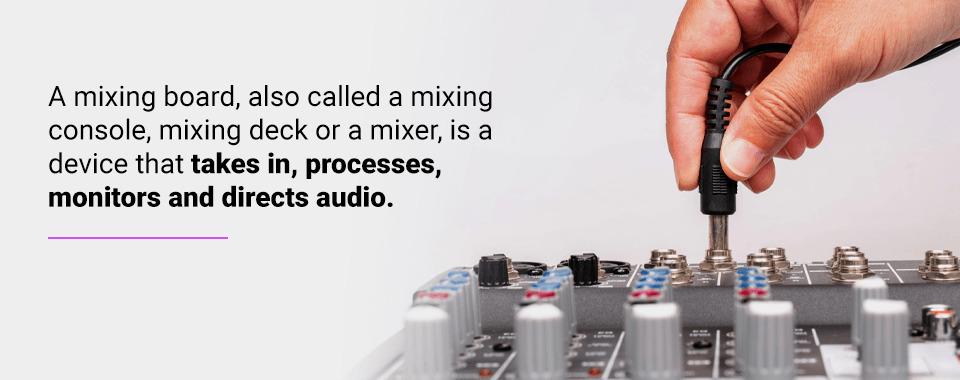
How do you use your venue? No matter how large or small your auditorium space is, it’s likely this theater plays host to a variety of diverse events. Consider every type of live performance your venue may showcase:
Though these five event categories only represent some of the many different events you may host, they each may require an audio system to possess specific capabilities. A mixing board, also called a mixing console, mixing deck or a mixer, is a device that takes in, processes, monitors and directs audio. The original mixers were analog. Today, the majority of equipment used for audio intake and distribution is digital, including a digital mixer.
The difference between digital and analog is essential to understand, especially when you’re choosing a new mixing board. In short, an analog format plays the original analog sound wave. A digital format samples the original analog sound wave, then converts it to numerical sequences of ones and zeroes. Finally, these numbers get turned into a voltage wave that mimics the analog wave.
Along with analog and digital mixers, there are also line mixers and powered mixers. Line mixers are typically analog and enable you to consolidate multiple sources into a dedicated output that frees up channels you can use for other devices. Although it’s a single unit, a powered mixer is both a mixer and power amplifier. Powered mixers are excellent resources for PA systems that need portability. Depending on your AVL needs, line mixers and powered mixers may give you the versatility and convenience you need.
One significant advantage of a digital wave is that it will never degrade over time. As long as the equipment can read and process the numbers, you’ll hear the identical sound wave every time. Analog sound waves, however, can degrade over time, resulting in distorted audio. Regardless of which mixer you choose, they will all have the same essential components like inputs and outputs, and will also be able to mix, balance and effect sound from sources connected to the mixer.
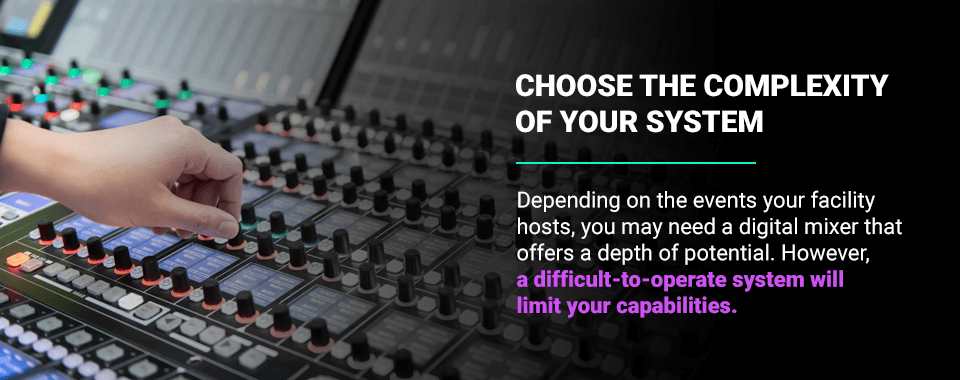
Because your mixer is a fundamental component of your complete sound system, you shouldn’t purchase the first digital mixer you find. Take a moment to evaluate both your current and future needs. You should determine your budget, choose the complexity of your audio mixing system, identify the processing power required for your desired results and consider which inputs, outputs and additional accessories you’ll need to use this mixer to its full potential.
How much is too much to spend on a digital mixer? How much is too little? Before you even compare digital mixers and their prices, you should first have a clear picture of your budget. Responsible planning makes responsible purchasing possible. Not only do you want to purchase a digital mixer that meets your current financial and operational needs, but you also want this product to continue meeting these needs for years to come. Consider these questions when determining your digital mixer budget:
You can affordably upgrade or design a new AVL system for your theater or event space. Understanding and responsibly working within the constraints of your budget is crucial. However, you must also fully understand the capabilities and limitations of each digital mixer, regardless of price.
As you begin browsing audio boards, you’ll undoubtedly discover the vast range of systems available. No two systems are identical, and although many of them may offer similar features, you need to research each thoroughly before you make a decision. One significant point of consideration is the complexity of the system itself. Different systems cater to varying needs. Depending on the events your facility hosts, you may need a digital mixer that offers a depth of potential. However, a difficult-to-operate system will limit your capabilities.
Although the technical specs of the digital mixer may be ideal, you need to pay close attention to its user interface as well. After all, how well will a premier audio system work if you cannot easily and effectively use it? When it comes to how to operate a mixer, understand the user interface can range from straightforward to complex. Some may use analog-style knobs and displays, while others will feature a fully digital touchscreen. As you learn about each interface, ask the following questions:
You want your board operator to feel comfortable, confident and empowered during every event. Some manufacturers offer versatile user interfaces that allow operators to control the mixer remotely via tablets, cell phones or other devices. Selecting a mixer that has a smooth and easily understandable user interface is the first step to ensuring their success.
Whether you’re replacing your old digital mixer or are building out the first sound system for your venue, it’s only natural you’re focusing on creating the optimal experience for your guests. Upgrading your AVL system is an exciting decision, and we know you can’t wait to see and hear the final product. Remember, what you get out of your digital mixer is what you put into it — literally. You need to consider how many physical channel inputs you’ll need to achieve the desired audio output.
There are a few key terms you should know when choosing your digital mixer. Whatever you connect into your mixer, such as instruments or microphones, will need to plug into an input channel, which is essentially a signal path. More channels enable you to input more devices. You can manipulate its frequencies with EQ or onboard effects. Mixers route channels into a bus that sends the sound to a speaker or recording system. You can also send the sound to processing gear outside the mixer via direct outs.
When you are inputting many channels into your mixer, you can manage them via channel grouping. This system is ideal, for example, if you want to send all inputs from rhythm instruments into one output and all inputs from vocal microphones into a separate output. You can also use mute grouping to control the group’s output. In the above instance, perhaps the rhythm portion ends before a song concludes. You can silence this entire section, so it cannot interfere with the remaining parts of the song.
If you currently use a digital mixer, first look at how many inputs it has and how many channels you typically use. Ideally, you should choose a mixer that has more inputs than the number you currently use. A good rule of thumb is to increase that number by roughly one and a half. For example, if you use five inputs, you will want to purchase a mixer that has at least seven.
If this is the first sound system your auditorium will have, don’t be afraid to ask a trusted AVL expert for advice. Depending on your live entertainment needs, and the level of scalability you anticipate, resources like the experienced technicians at Illuminated Integration will help you identify how many inputs you need. Keep in mind you can also purchase external input/output boxes as a last resort. However, it’s better to initially choose a mixer that provides you with extra inputs, so you have adequate room to grow.
Processing power is another vital element that needs consideration. Similar to how processors work on your home computer, processors within a digital mixer influence operating speed. The processor communicates with other components in the board, providing instructions that cause other applications to run. A slow processor limits swiftness, while a robust processor enhances it. One of the significant benefits of choosing a digital mixer over analog versions is that it offers exceptional digital signal processing capabilities.
Most digital mixers, even those that are not complex or robust, offer real-time onboard processing. Analog mixers require an additional digital component to achieve these capabilities. Digital mixers can provide equalization across multiple bands of frequency, filter all channels on each input, output and bus, suppress feedback on these channels and correct pitch. Some are programmable to automatically mix incoming audio from mics in real time. Depending on the range of features, a digital mixer may also include onboard effects that offer more variety and versatility for performances.
A high digital signal processing power will never hurt your system. However, these capabilities may be well beyond your intended use. As you look deeper into processing power, understand which applications a more robust processor would be necessary for. For instance, a digital mixer with a robust processor and various onboard effects is ideal for facilities that showcase live music. In contrast, a respectable processor with limited effects may be a better fit for a community center that primarily uses an audio system for public speaking engagements or intimate events.
Maybe you’re undergoing a full AVL system overhaul, or perhaps you’re merely replacing your analog mixer with a digital board — in every case, you need to consider how all elements of the system interact with one another. For this system to work seamlessly, all components need to connect and be compatible with the parts of a mixer board. Consider the accessories you may use with your new digital mixer:
How you use your audio mixing board is just as important as why you use it. Consider again how many devices you’re connecting via inputs and what other types of equipment you’ll like to use in the future. One issue some venues encounter is that their older equipment or systems are not compatible with their new digital mixer. This problem is easy to avoid with a little forethought and research. Before you finalize your digital mixer decision, determine whether or not your current system components will connect seamlessly.
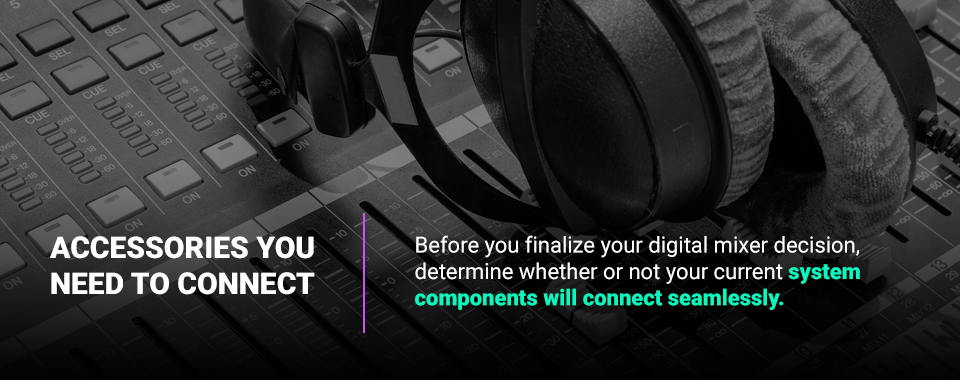
At the heart of every event you host in your venue should be an AVL system equipped to showcase these diverse performances perfectly. Using the highest-quality equipment, cutting-edge technology and innovative design, Illuminated Integration creates one-of-a-kind AVL design builds for clients across a spectrum of industries. Our design team specializes in designing and installing customized audio, video and lighting systems in facilities of all sizes. From school auditoriums and community centers to historic theaters and brand-new live entertainment venues, we deliver unparalleled results in every project.
Together, we’ll work side by side through the entire AVL process, from concept design to final installation. We’ll take your vision, evaluate your needs and assess your venue to determine how we can integrate a dynamic AVL system to capture your desired experience. Because we tailor our designs precisely for your facility, we will make the necessary modifications to meet all building codes or organizational needs. You’ll be involved in every aspect of the design and implementation process, ensuring you receive the system of your dreams.
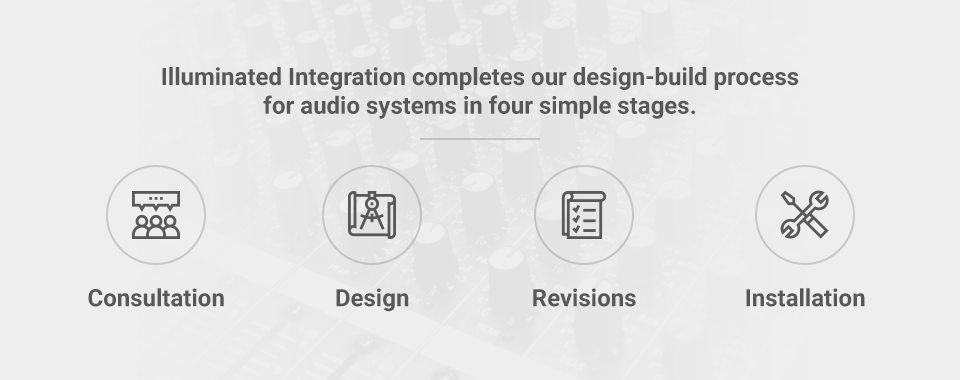
Illuminated Integration completes our design-build process for audio systems in four simple stages.
We’re more than an AVL design company — we’re a trusted resource you can rely on. Our professional team members have decades of combined experience that enable us to design systems that achieve a unified user experience. We’ll walk you through our process, explaining how each component of these versatile systems creates the perfect sensory environment. Illuminated Integration is ready to provide you with a seamless approach for AVL design, implementation and installation, with the ability to expertly integrate each of the following into your venue:
With ongoing expert support even after your project concludes, Illuminated Integration is ready to make your AVL dream a vivid reality.
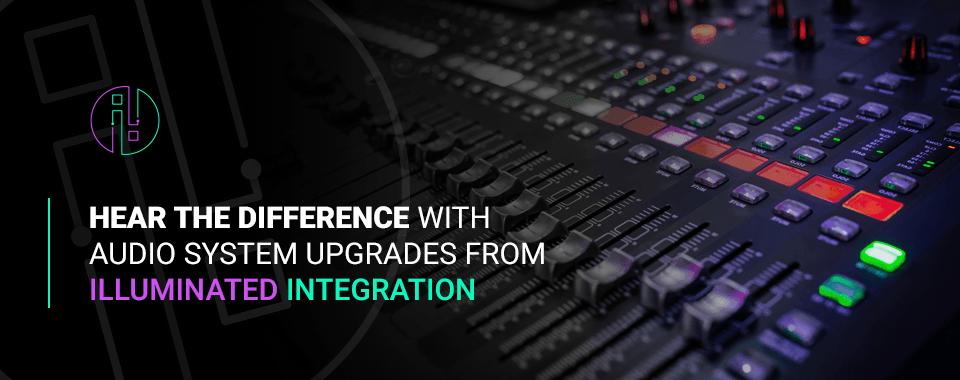
An AVL system is an essential component of your live performance venue. Whether you’re completing a brand-new AVL design-build or choosing individual components to integrate into your existing system, you need to consider the unique spatial needs of your facility and the diverse needs of the events you host. From comparing digital vs. analog mixers to evaluating which lighting sources provide the ideal visibility, every element of your AVL design requires careful thought and planning.
Ensure your AVL design-build produces the dynamic results your event space needs. To learn more about digital mixers and how to successfully integrate them into your AVL design, or to discover other ways you can improve the audio, video and lighting systems in your venue, contact Illuminated Integration today.